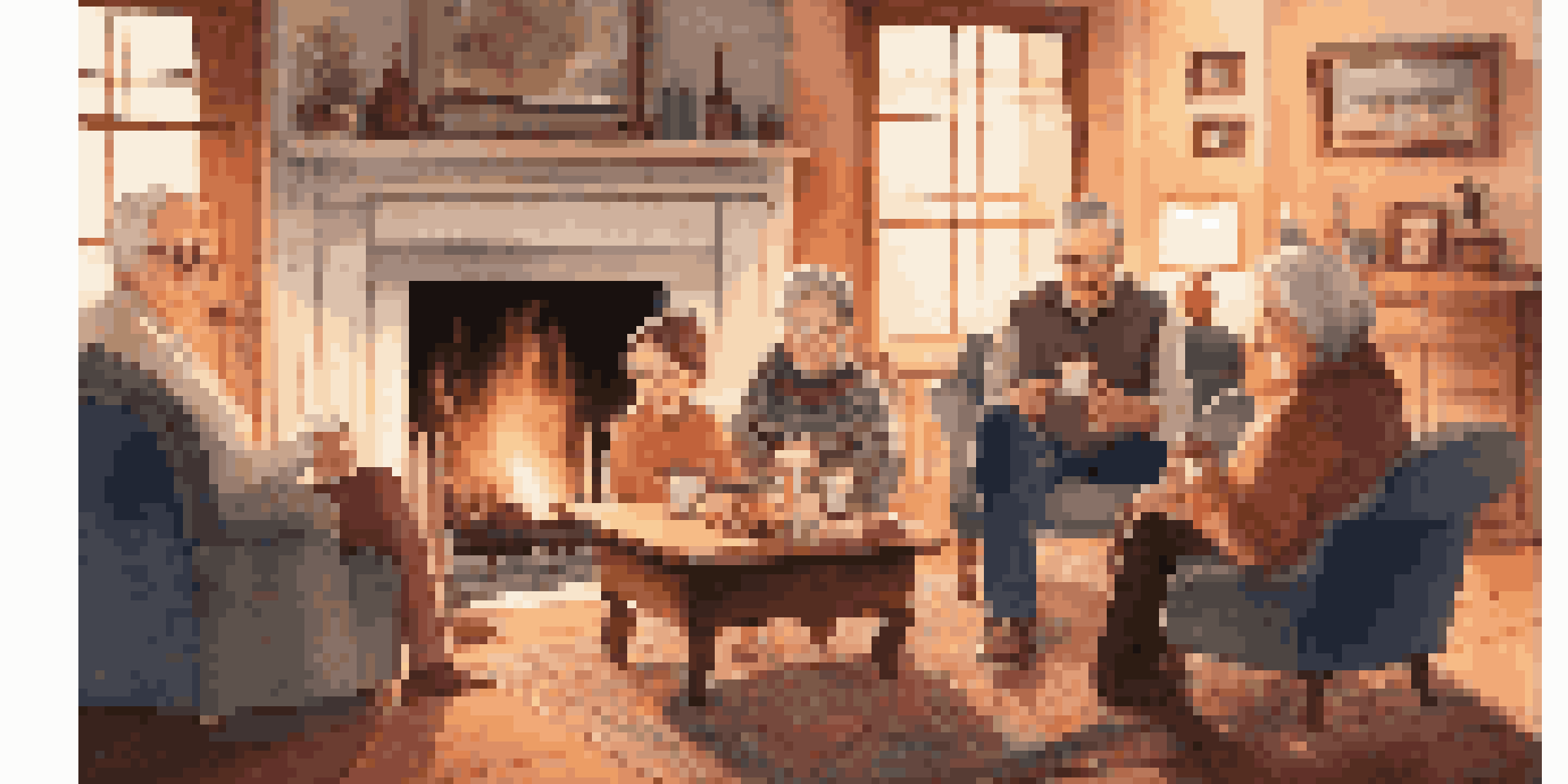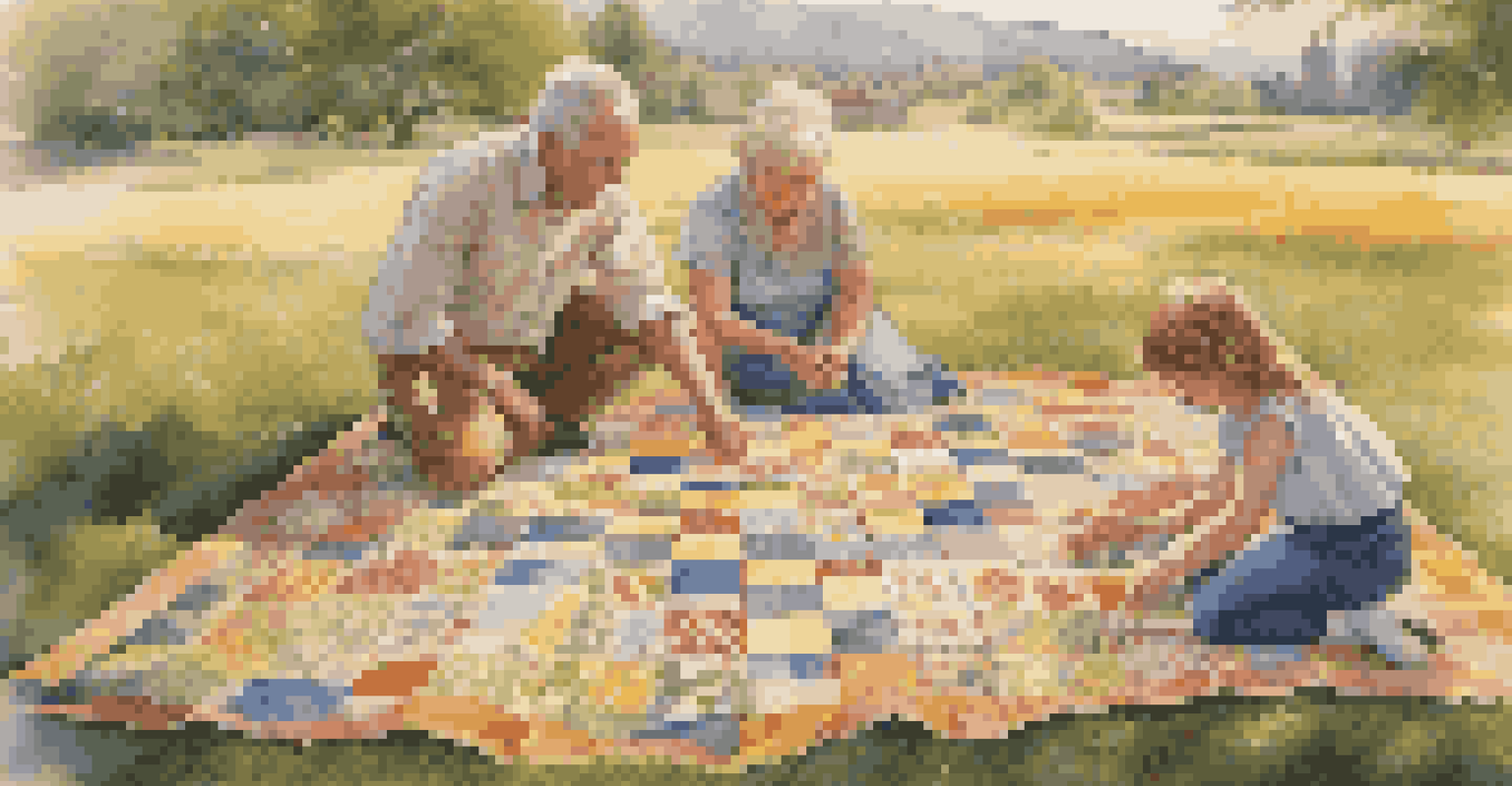The Role of Art in Preserving Family Histories and Memories

Art as a Storyteller of Generations
Art has a unique ability to tell stories, often capturing moments that words cannot express. From paintings to sculptures, each piece can encapsulate the essence of a family's journey through time. Just like a photograph freezes a moment, art can evoke emotions tied to memories, bringing past experiences to life.
Art enables us to find ourselves and lose ourselves at the same time.
Consider a family portrait painted by a relative, where each brushstroke reflects not just physical features but the personality and spirit of each family member. Such artwork serves as a visual narrative that can be passed down through generations, bridging the gap between the past and the present. This connection fosters a sense of belonging and identity, reinforcing the family's legacy.
Moreover, art can record significant life events—births, weddings, and anniversaries—allowing families to revisit these milestones through creative expressions. By integrating art into family traditions, we create a living tapestry that honors our histories and keeps the memories alive.
Artistic Expressions of Heritage
Art often reflects cultural backgrounds, making it a powerful tool for preserving family heritage. Traditional crafts, folk art, and cultural symbols not only celebrate a family's roots but also educate future generations about their ancestry. By engaging with these artistic forms, families can connect with their cultural narratives in a meaningful way.

For example, creating a family quilt using patterns that represent different aspects of a family's history can be both a creative project and a bonding experience. Each square might signify a story, a memory, or a family tradition, creating a tangible representation of their heritage. This not only keeps the past alive but also ignites curiosity among younger family members about their origins.
Art Connects Generations
Art serves as a powerful medium that captures and preserves family stories, fostering a sense of belonging and identity across generations.
In this way, artistic expressions serve as a bridge between cultures, allowing families to honor their histories while adapting them for contemporary life. By embracing and creating art that reflects their heritage, families ensure that their stories are not lost but celebrated and shared.
Art as a Tool for Healing and Reflection
Art can also play a crucial role in processing emotions and memories, especially during difficult times. Creating or engaging with art allows individuals to express feelings that might be hard to articulate. Whether it's painting a canvas or crafting a scrapbook, these activities can provide a therapeutic outlet for family members to connect with their emotions.
Every artist was first an amateur.
For instance, a family grieving the loss of a loved one might come together to create a memorial piece, such as a collage of photographs and mementos. This collaborative effort not only honors the deceased but also fosters healing through shared remembrance. It transforms grief into a celebration of life, turning painful memories into a source of connection.
Furthermore, art can create a safe space for families to reflect on their journeys, both joyous and challenging. By engaging in artistic activities, family members can dialogue about their experiences, allowing for deeper understanding and empathy within the family unit. This reflection enriches their collective memory, creating a stronger bond.
Preserving Memories through Creative Collaboration
One of the most enriching ways to preserve family histories is through collaborative art projects. Families can come together to create a mural, a scrapbook, or even a video montage, intertwining their individual stories into a collective memory. This process not only strengthens family ties but also ensures that everyone's voice is heard and valued.
Think about how a collaborative family tree artwork can visually represent each member's contributions to the family legacy. Each branch can symbolize relationships, milestones, and shared experiences, creating a dynamic representation of their history. This collective approach to art-making encapsulates the essence of family unity and shared identity.
Cultural Heritage Through Art
Artistic expressions reflect cultural backgrounds, helping families celebrate their roots while educating future generations about their ancestry.
Moreover, these collaborative projects can become cherished heirlooms, passed down as symbols of love and togetherness. They serve as reminders of the creativity and resilience of a family, ensuring that memories are not just told but lived through every artistic endeavor.
Art as a Medium for Storytelling
Storytelling is an art form in itself, and when families share their histories through narratives, they keep memories alive. Whether it's through written stories, oral histories, or performance art, each method has the power to convey the richness of family experiences. These stories can be woven into family gatherings, creating a living tradition that honors the past.
Imagine gathering around a fireplace, with family members sharing tales of ancestors who faced hardships or celebrated triumphs. This storytelling not only entertains but also imparts valuable lessons and insights, ensuring that future generations learn from the past. Each story, much like a piece of art, carries emotions and lessons that resonate deeply with listeners.
Additionally, recording these stories in a creative format—such as a family book or a podcast—can preserve them for years to come. By combining storytelling with art, families create a multi-dimensional narrative that captures both the essence of their experiences and the spirit of their loved ones.
Utilizing Digital Art for Modern Memories
In today's digital age, technology offers exciting new ways to preserve family memories through art. Digital platforms allow for the creation of family videos, photo montages, and even virtual family trees that can be shared and updated easily. This modern approach not only makes art accessible but also encourages families to engage with their histories in innovative ways.
For instance, creating a digital scrapbook can capture memories from various family events, combining photos, videos, and even audio clips. This multimedia representation breathes new life into family stories, making them interactive and engaging for younger generations. By incorporating technology, families can ensure that their histories are preserved in formats that resonate with today's digital natives.
Collaborative Art Projects Unite Families
Engaging in collaborative art projects strengthens family bonds and creates shared memories that become cherished heirlooms.
Moreover, social media platforms offer a space for families to celebrate their art and memories publicly. Sharing artwork, stories, and experiences online can foster connections with extended family members and friends, creating a broader community of shared history. This digital storytelling not only preserves memories but also allows for ongoing dialogue about family legacies.
The Lasting Impact of Art on Family Legacies
Ultimately, the role of art in preserving family histories and memories is profound and far-reaching. Art not only serves as a record of the past but also shapes the identity of families as they navigate the present and future. Each piece of art created is a testament to the love, resilience, and creativity that define a family’s legacy.
By engaging with art in various forms—be it through storytelling, collaborative projects, or digital mediums—families can ensure that their histories are not just remembered but celebrated. This ongoing engagement with art fosters a sense of pride and belonging, encouraging future generations to continue the tradition of preserving their stories.

In essence, art becomes a living legacy, connecting families across time and space. It invites families to reflect on their past, celebrate their present, and inspire their future, ensuring that the stories and memories that define them endure for generations to come.